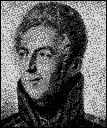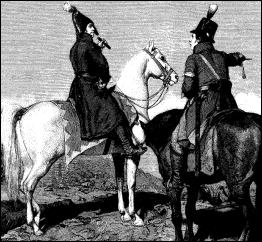Johan August Sandels (1764-1831)
 Sandels was born in Stockholm on august 31, 1764 and already in 1775 he joined the army and was in 1777 made underlieutenant at the artillery. In 1785 he was moved over to the Finnish army as Stabsryttmästare (Rittmeister in German, in English that should correspond to captain as military rank). Two years later he made major and during the 1788-90 war he single handedly put up a batallion of six hundred troops with which he fought in Finland. After having fought the war he was made lieutenant colonel at the Karelian dragoon regiment and already in 1799 he had advanced to colonel of the army. In 1803 he took command over the Savolax fieldjaeger (fältjägar) regiment.
Sandels was born in Stockholm on august 31, 1764 and already in 1775 he joined the army and was in 1777 made underlieutenant at the artillery. In 1785 he was moved over to the Finnish army as Stabsryttmästare (Rittmeister in German, in English that should correspond to captain as military rank). Two years later he made major and during the 1788-90 war he single handedly put up a batallion of six hundred troops with which he fought in Finland. After having fought the war he was made lieutenant colonel at the Karelian dragoon regiment and already in 1799 he had advanced to colonel of the army. In 1803 he took command over the Savolax fieldjaeger (fältjägar) regiment.
The war of 1808-09 opened up new horizons for this born warrior. On april 7, 1808 Sandels took command of the fifth brigade which consisted of 3200 troops and with these he successfully led the resistance against the Russians in the eastern parts of Finland. In the beginning his brigade mostly consisted of untrained, fresh troops and the larger part of his force had to stay in Uleåborg to continue military education, he actually only had about 1400 when he went southeast to face the Russians. The war of 1808 was fought on three fronts; the western theatre of war included Österbotten, where the main armies were fighting; the southern theatre was the war fought between the coastal fleets in the Åbo-Åland archipelago (where Swedish troops made sporadic landings); and then there was Sandels theatre in the east (around the city of Kuopio).
Sandels immediately went on the offensive and on the 2nd of may he beat the Russians under Obuhov at a battle near Pulkkila. After a short fight on may 9, Sandels liberated Kuopio from the Russian army. The Russian commander Buxhoevden was now starting to sweat, and he immediately ordered fresh reinforcements to collect at the border for operations against Sandels brigade. It took time to get new troops ready though and Sandels did not sit around waiting. He instead made daring operations, took Russian depots and threatened them all the way to the Russian-Finnish border. At the end of may, the Russian reinforcements were marching up though and they were led by Barclay de Tolly. This ended Sandels offensive and he fell back. While Sandels only had had 1500 troops in his offensive, the Russian army was committing 5.000 men against him. By all means, this offensive had been one of the most remarkable events of the entire war.
After the fall of Sveaborg, Sandels had to give in for the overwhelming odds and he retreated to the pass at Toivola, a few miles north of Kuopio, where he successfully defended himself against almost daily Russian attacks until september 30. After Toivola, Sandels retreated north to Idensalmi, followed by the Russian army under Tutjkov. At Idensalmi Sandels took post as he heard of the armistice at Lochteå.
 The Russians broke the armistice on october 27, 1808 as more than 5.800 troops came against Sandels. He had found himself a good position for defence though, and the Russians had to cross the bridge at Koljonvirta - also called Virta bro - to get to the Swedes. The Russians came over under screams and with playing music, their attack was total. But keeping his coldness, Sandels waited for the right moment. And then the order was given. With shining bayonets the Vasa regiment and Savolax jaegers went to the attack; they were followed by a battallion from Uleåborg as well as Karelian dragoons. The success was total. The Russian troops were turned over in rout and defeat; they were driven back towards the bridge. The Swedes brought them hard losses as they fullfilled bayonet-charges and let their weapons play against the confused formations of Russian soldiers. Tutjkov himself was wounded in the battle.
The Russians broke the armistice on october 27, 1808 as more than 5.800 troops came against Sandels. He had found himself a good position for defence though, and the Russians had to cross the bridge at Koljonvirta - also called Virta bro - to get to the Swedes. The Russians came over under screams and with playing music, their attack was total. But keeping his coldness, Sandels waited for the right moment. And then the order was given. With shining bayonets the Vasa regiment and Savolax jaegers went to the attack; they were followed by a battallion from Uleåborg as well as Karelian dragoons. The success was total. The Russian troops were turned over in rout and defeat; they were driven back towards the bridge. The Swedes brought them hard losses as they fullfilled bayonet-charges and let their weapons play against the confused formations of Russian soldiers. Tutjkov himself was wounded in the battle.
The battle of Virta bro was the last Swedish military victory on Finnish soil.
Shortly thereafter the convention of Olkijoki was signed, which stated that the Swedish armies were to leave Finland. The war was brought into northern Sweden as the Russian troops occupied large parts of Norrland. The Russian armies took Umeå. In 1809 Sandels took command over the Swedish troops in Western Norrland and he there fought his war successfully, while the luck was never with the other Swedish commanders. Sandels was at this time under the command of general Wrede. At about the same time as all this, Sandels had been made friherre. On July 5, Sandels delivered battle at Hörnefors and he there won a victory over far superior Russian forces. On august 9, the battle of Sävar was fought, where Kamenskij defeated the Swedish under Wachtmeister. Wachtmeister had been landed in the back of the Russians and his mission was to take Umeå in cooperation with Wrede. The plan failed due to bad cooperation between the two, but nonetheless, Sandels troops marched into Umeå, that had been left open by the Russians. In 1809 he had married Ulla Elisabet Hermelin.
After the war, Sandels was made sekundchef ("second chief") at Svea Lifgarde in 1812, and after having been made lieutenant general he went with the army to Germany to fight alongside Bernadotte. He took part in the battles of Grossbeeren, Dennewitz and was also present at Leipzig. After having gone with the army to Holstein (Kiel 1814), he fought in Belgium, where he was commander at the siege of Maastricht. In July 1814, he commanded the second division that went into Norway as Sweden annexed that country from Denmark.
In 1815 he was made count and he retired from his post as commander of Svea Lifgarde. He received Serafimerorden by 1817 and took part in the Swedish parliament, riksdagen, as Landmarskalk. Thereupon, he was made general of the infantry in 1818, and at the same time governor of Norway. With Bernadotte Sandels became very impopular at this time, as Sandels had Norwegian sympathies. Nonetheless he was made Fieldmarshal in 1824. Sandels retired from his post in november 1827, due to bad health, and died in Stockholm on january 22, 1831.
Sandels was, next to Georg Carl von Döbeln, the general that received the largest respect among the Finnish during the 1808-09 war. Sandels was said to have been a very handsome man, with authority and cold bravery that earned him respect among both friends and foes. He was a real aristocrat, and kept his distance from the men, and therefore received a lot of respect, but never true popularity. But he had a good eye for the warfare in the Finnish terrain and knew exactly what needed to be done. He was a military genius, and that showed as he time upon time kept far superior enemy troops at bay.
Back to Biographies
© Göran Frilund 2000-03, All Rights Reserved.
If you've surfed onto this page from outside and there is no menu on the left,
CLICK HERE for the full Website.
 Sandels was born in Stockholm on august 31, 1764 and already in 1775 he joined the army and was in 1777 made underlieutenant at the artillery. In 1785 he was moved over to the Finnish army as Stabsryttmästare (Rittmeister in German, in English that should correspond to captain as military rank). Two years later he made major and during the 1788-90 war he single handedly put up a batallion of six hundred troops with which he fought in Finland. After having fought the war he was made lieutenant colonel at the Karelian dragoon regiment and already in 1799 he had advanced to colonel of the army. In 1803 he took command over the Savolax fieldjaeger (fältjägar) regiment.
Sandels was born in Stockholm on august 31, 1764 and already in 1775 he joined the army and was in 1777 made underlieutenant at the artillery. In 1785 he was moved over to the Finnish army as Stabsryttmästare (Rittmeister in German, in English that should correspond to captain as military rank). Two years later he made major and during the 1788-90 war he single handedly put up a batallion of six hundred troops with which he fought in Finland. After having fought the war he was made lieutenant colonel at the Karelian dragoon regiment and already in 1799 he had advanced to colonel of the army. In 1803 he took command over the Savolax fieldjaeger (fältjägar) regiment. The Russians broke the armistice on october 27, 1808 as more than 5.800 troops came against Sandels. He had found himself a good position for defence though, and the Russians had to cross the bridge at Koljonvirta - also called Virta bro - to get to the Swedes. The Russians came over under screams and with playing music, their attack was total. But keeping his coldness, Sandels waited for the right moment. And then the order was given. With shining bayonets the Vasa regiment and Savolax jaegers went to the attack; they were followed by a battallion from Uleåborg as well as Karelian dragoons. The success was total. The Russian troops were turned over in rout and defeat; they were driven back towards the bridge. The Swedes brought them hard losses as they fullfilled bayonet-charges and let their weapons play against the confused formations of Russian soldiers. Tutjkov himself was wounded in the battle.
The Russians broke the armistice on october 27, 1808 as more than 5.800 troops came against Sandels. He had found himself a good position for defence though, and the Russians had to cross the bridge at Koljonvirta - also called Virta bro - to get to the Swedes. The Russians came over under screams and with playing music, their attack was total. But keeping his coldness, Sandels waited for the right moment. And then the order was given. With shining bayonets the Vasa regiment and Savolax jaegers went to the attack; they were followed by a battallion from Uleåborg as well as Karelian dragoons. The success was total. The Russian troops were turned over in rout and defeat; they were driven back towards the bridge. The Swedes brought them hard losses as they fullfilled bayonet-charges and let their weapons play against the confused formations of Russian soldiers. Tutjkov himself was wounded in the battle.